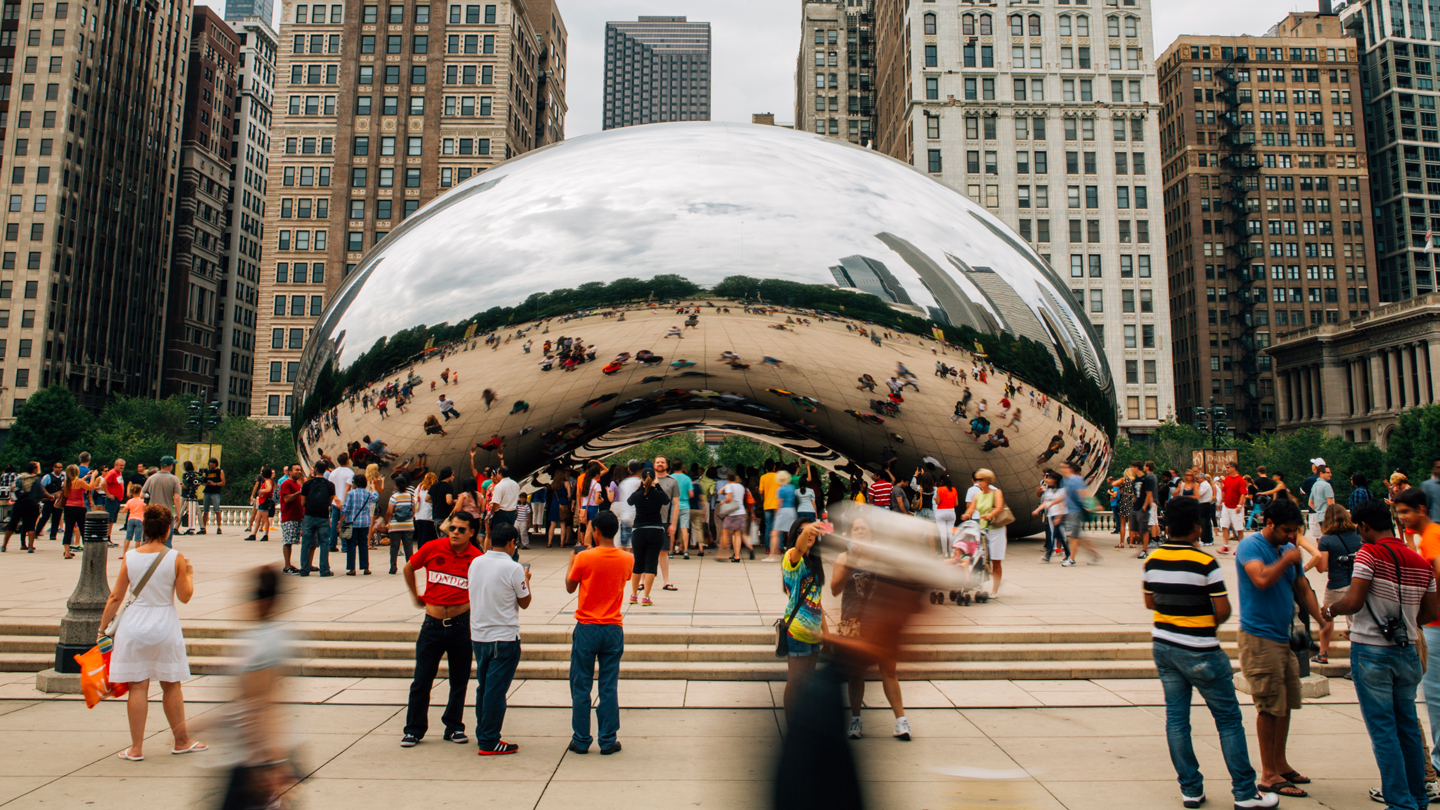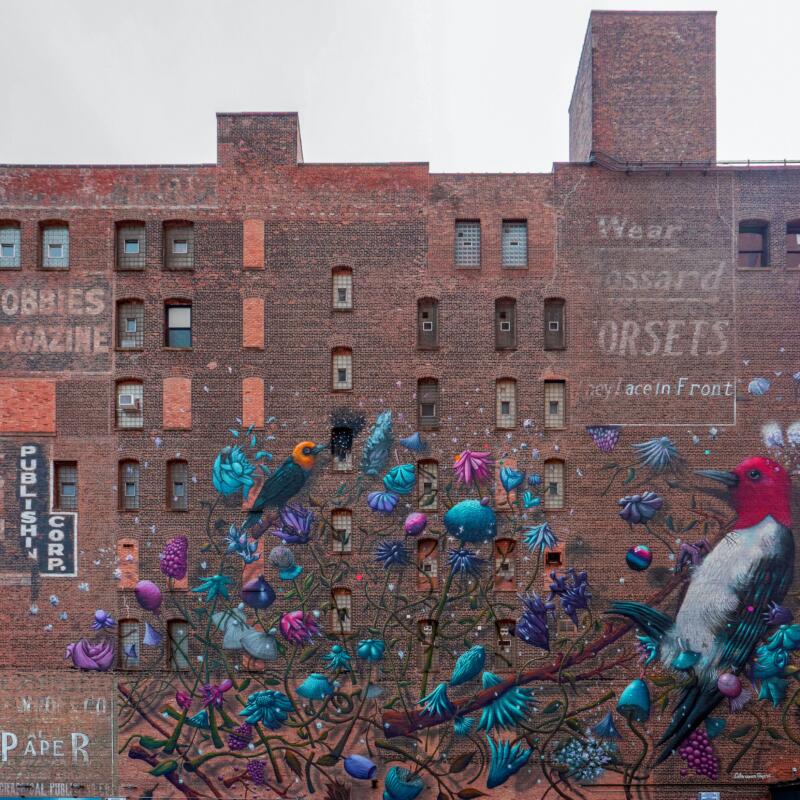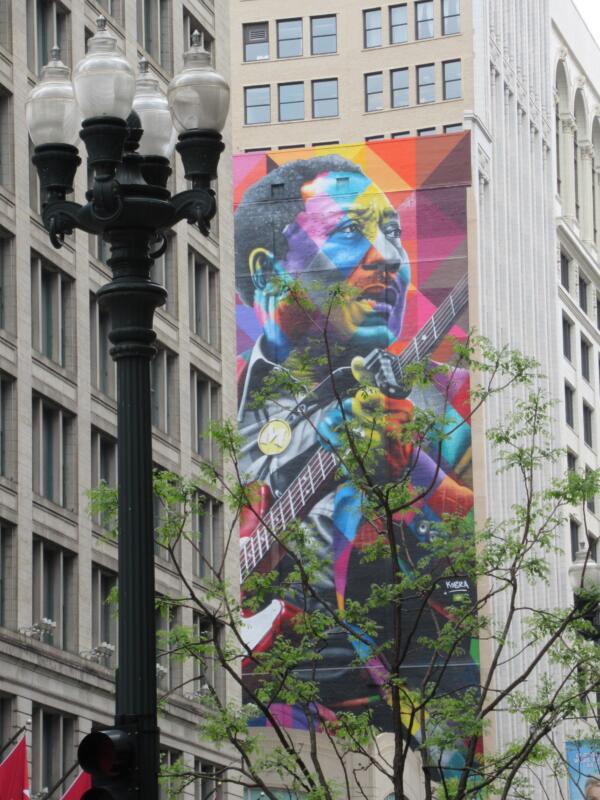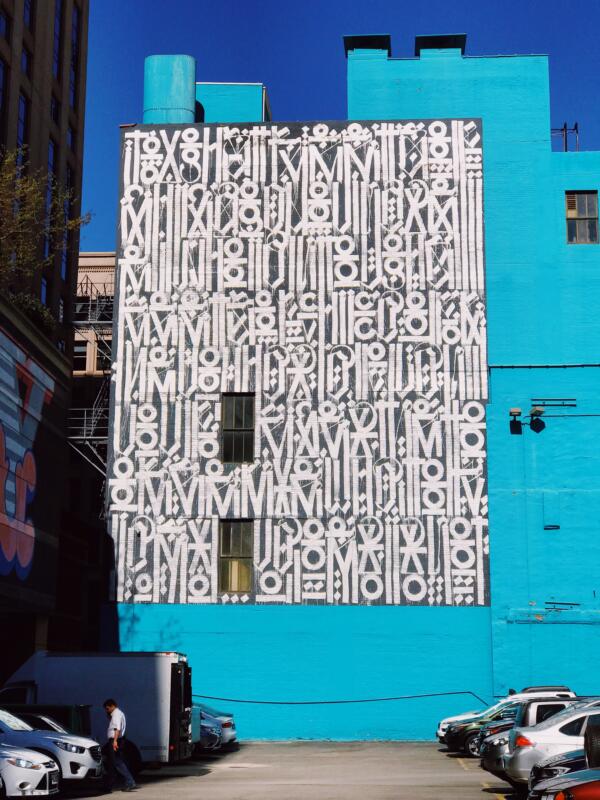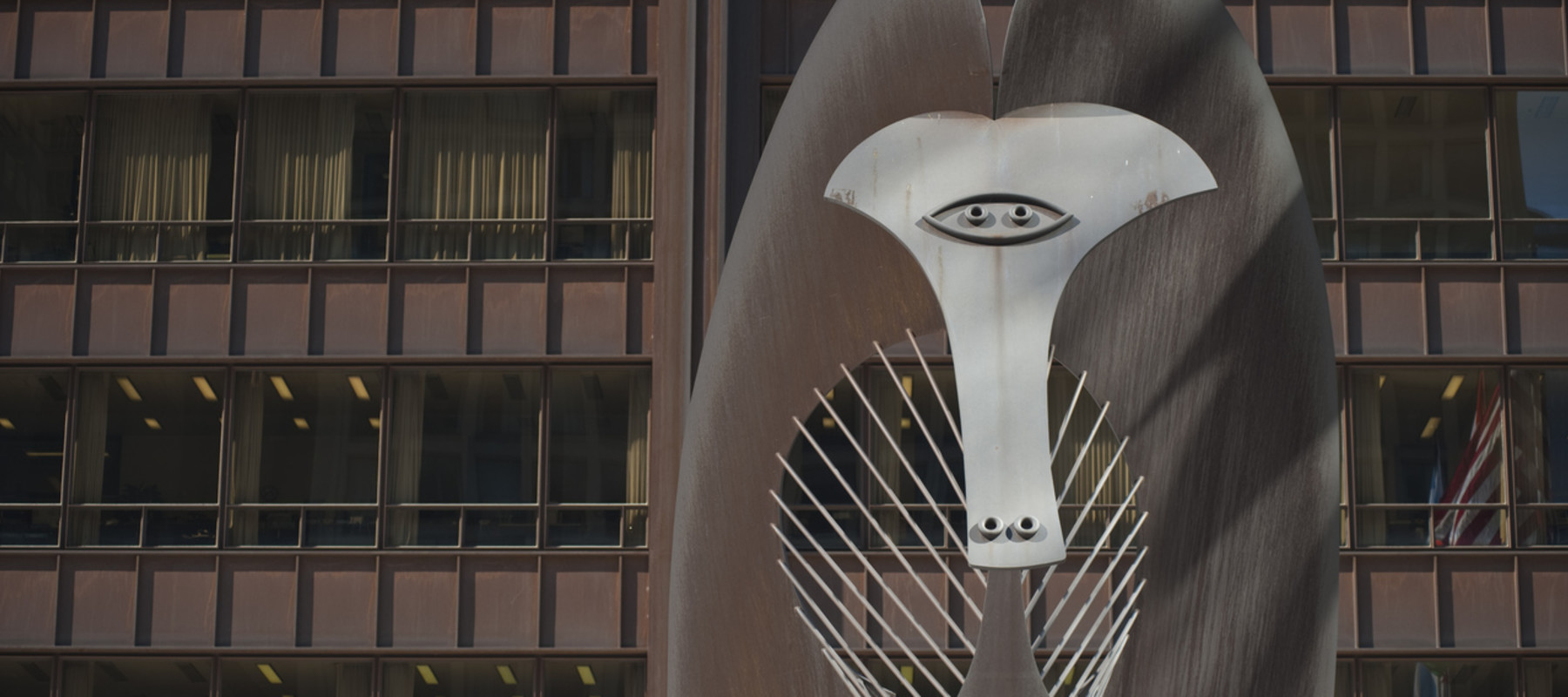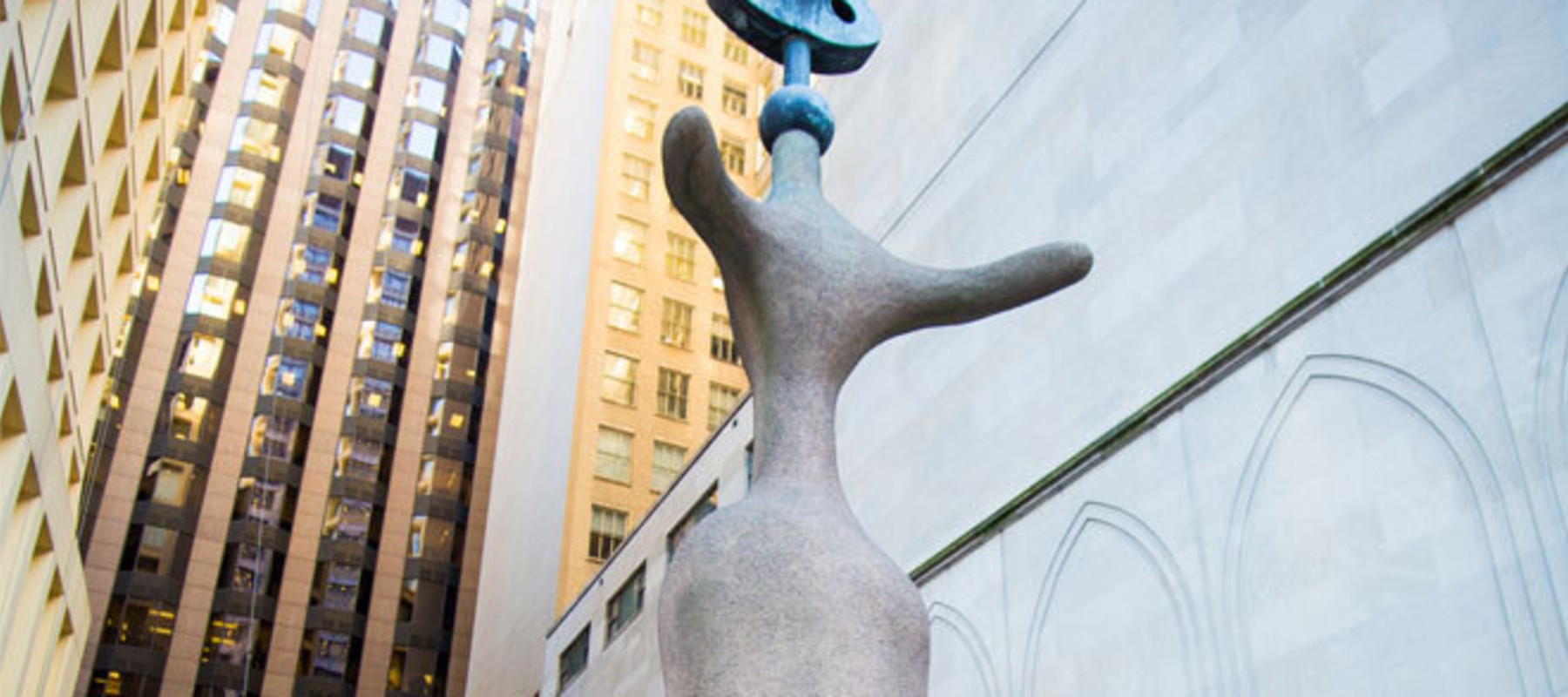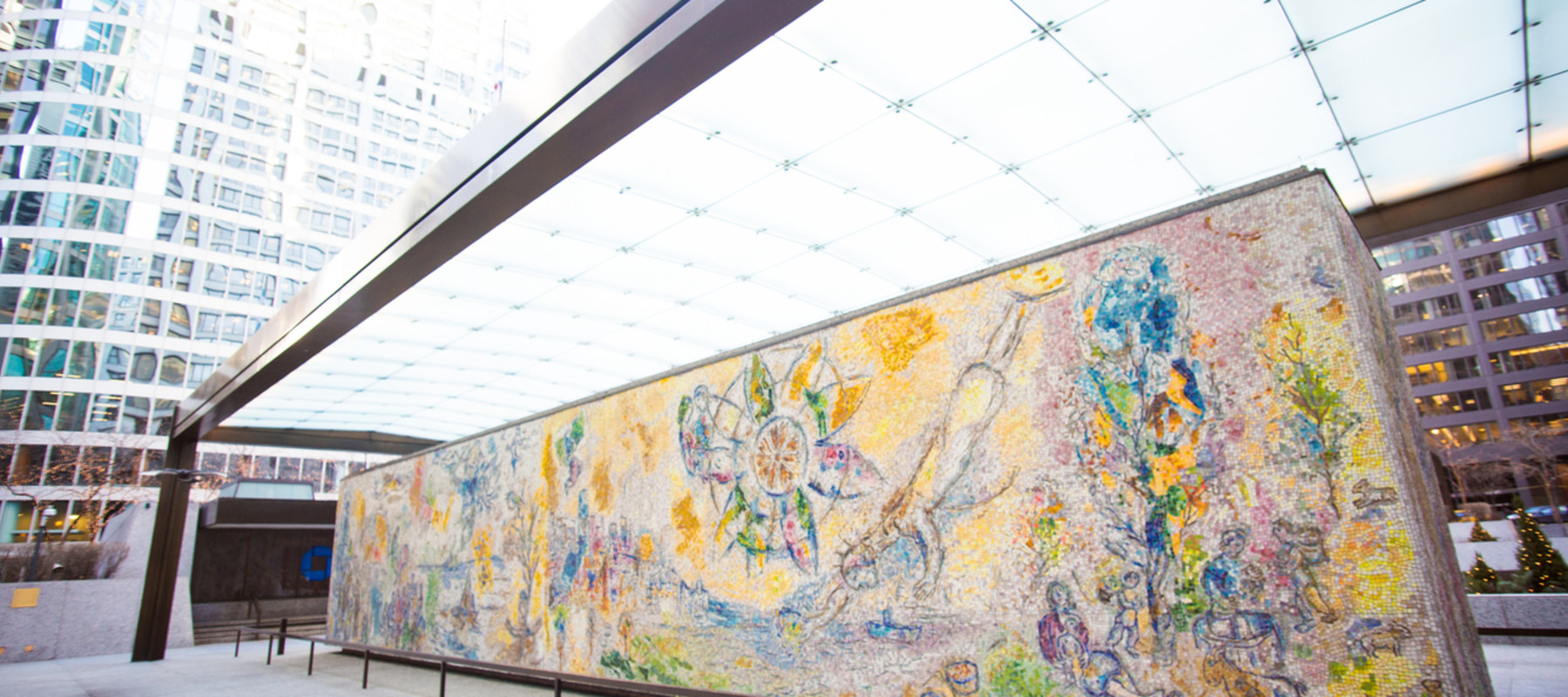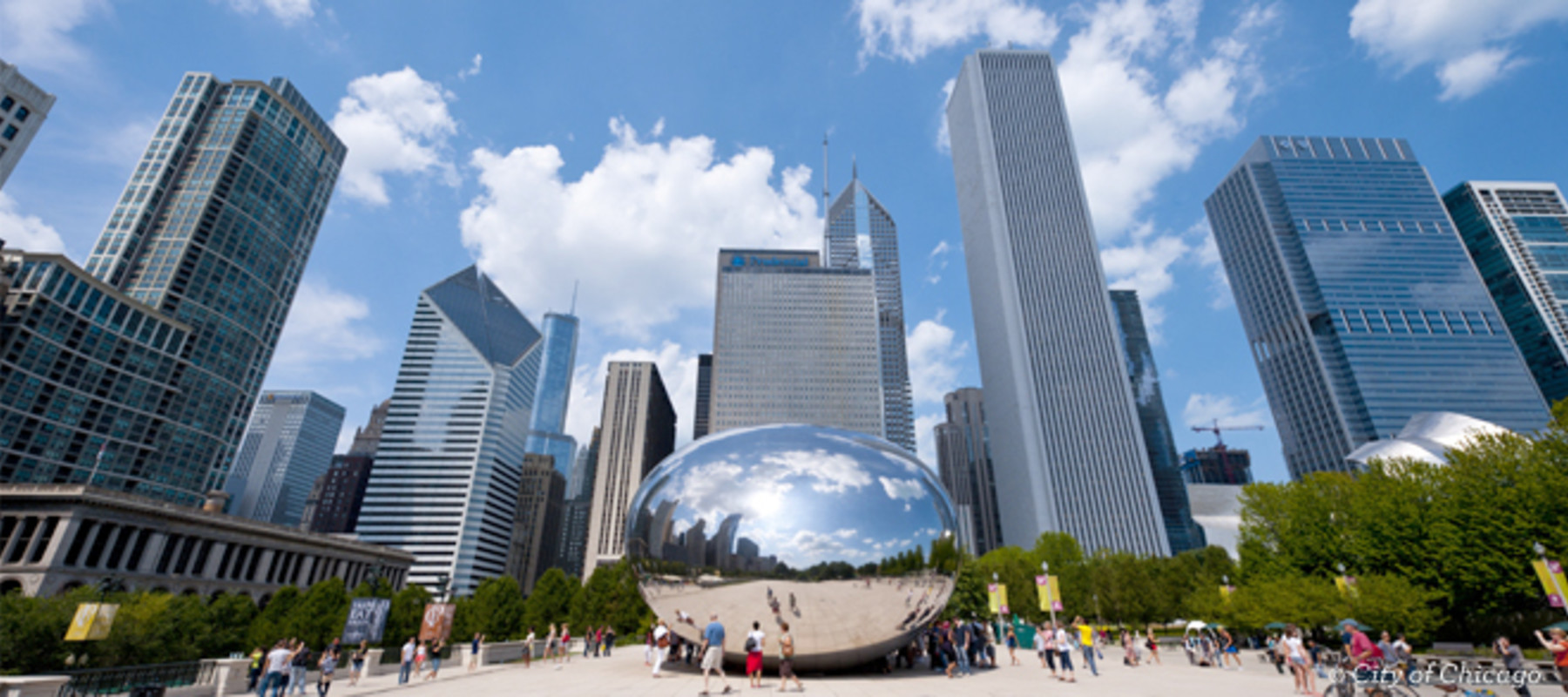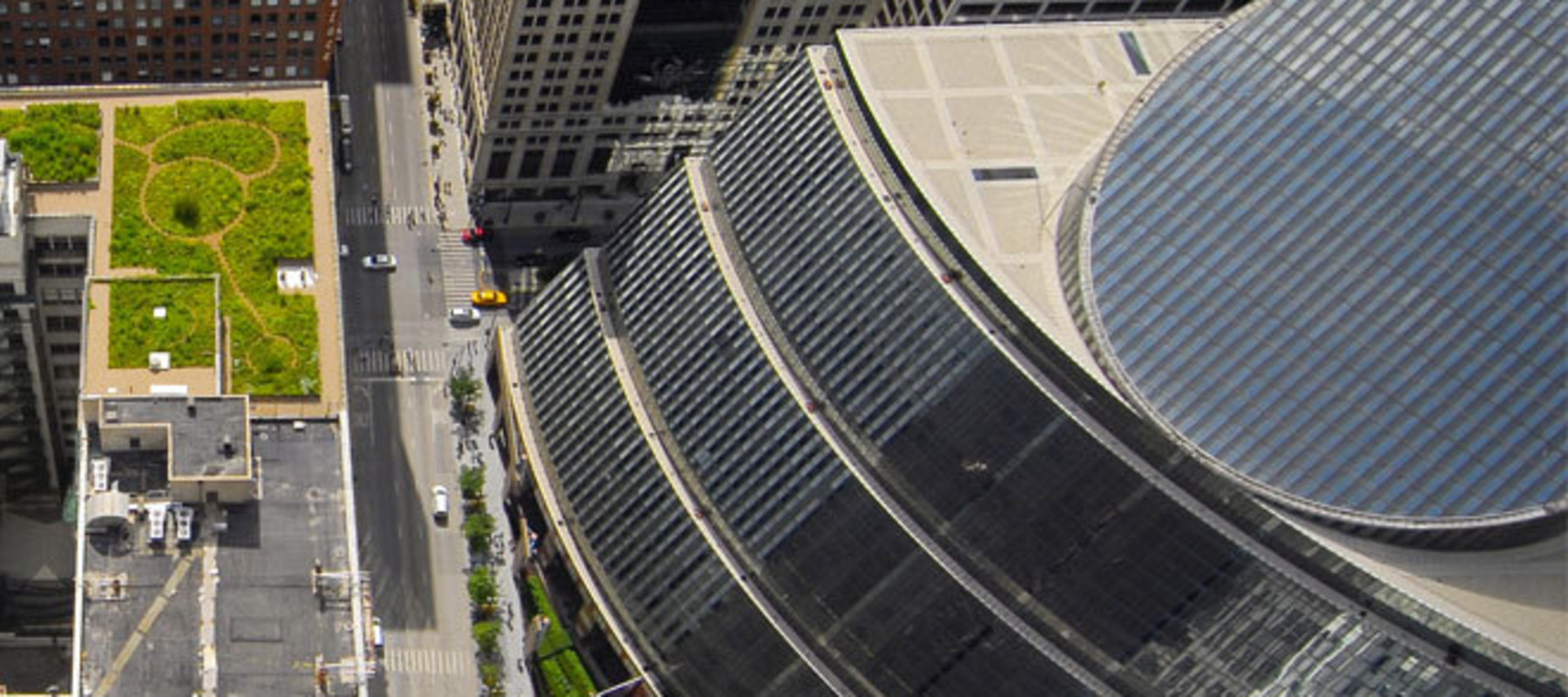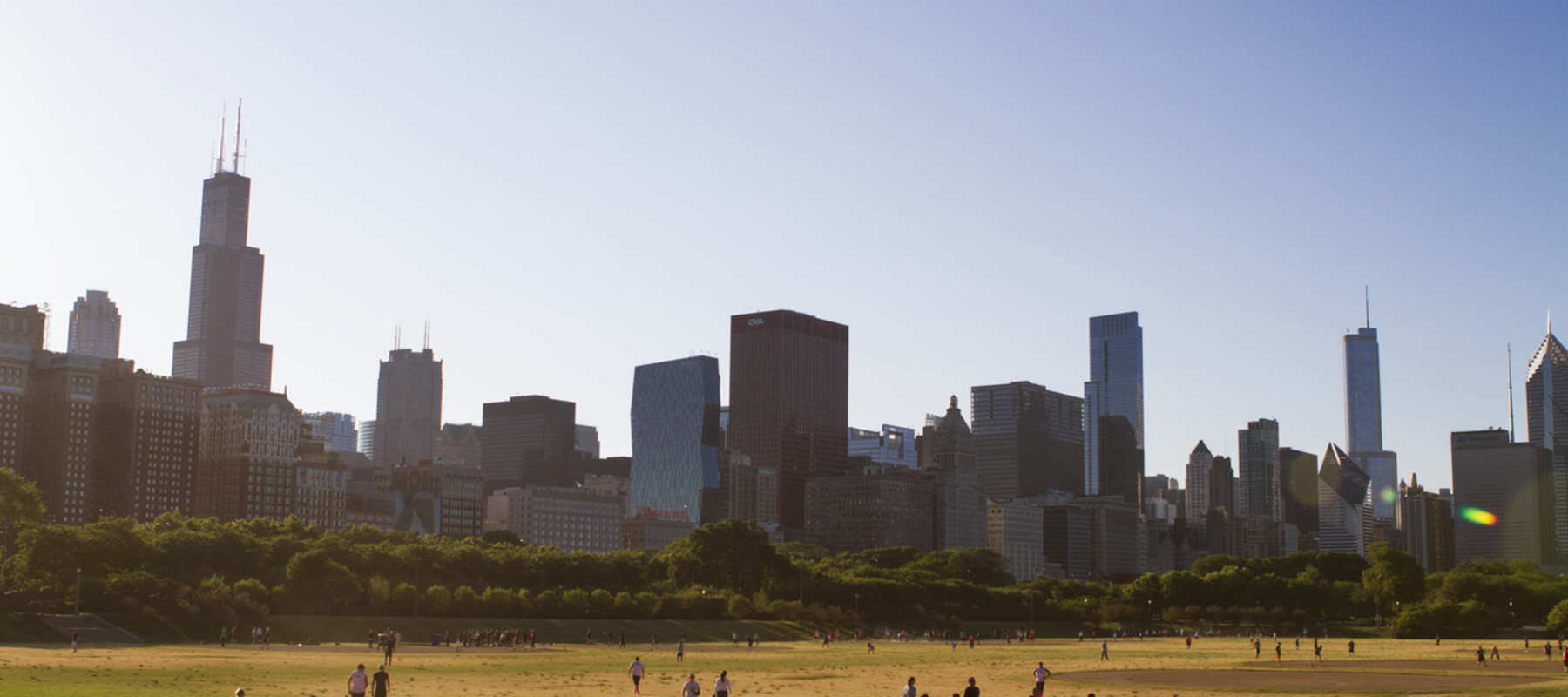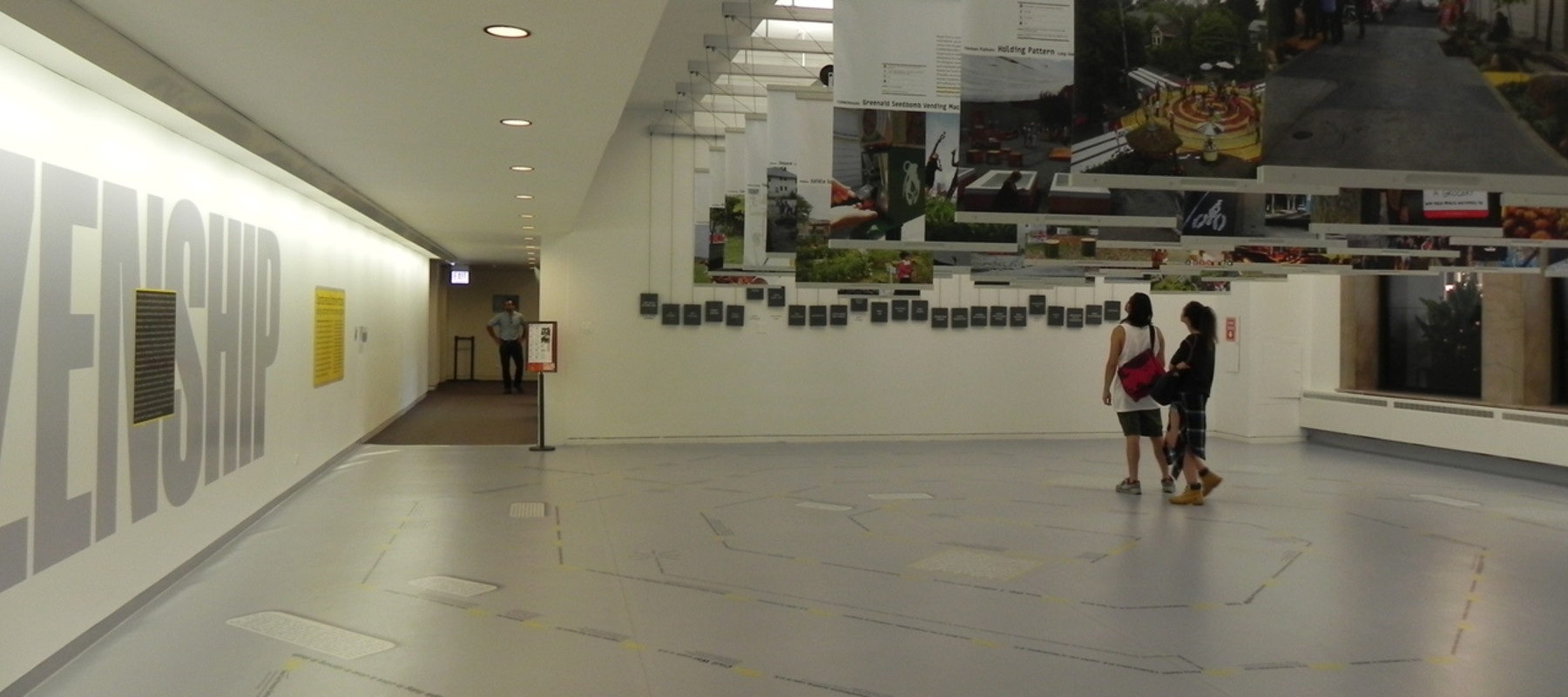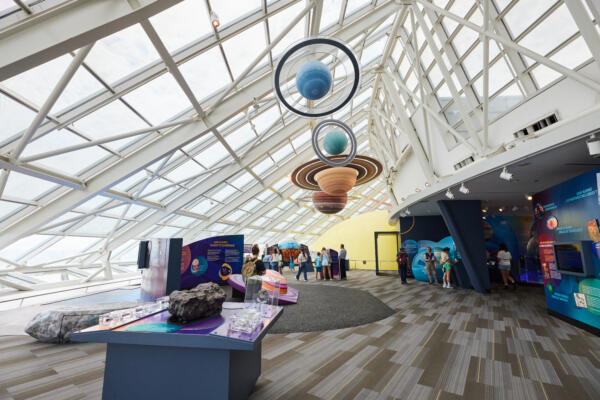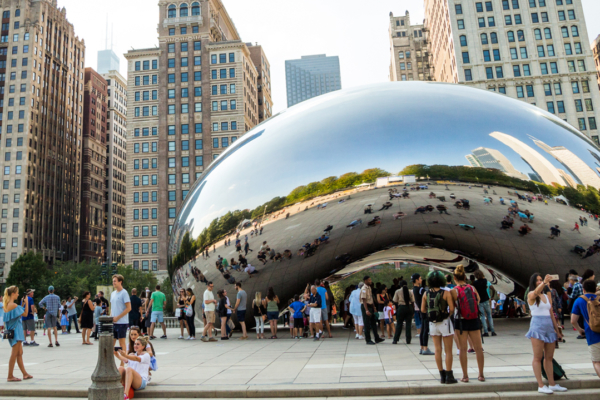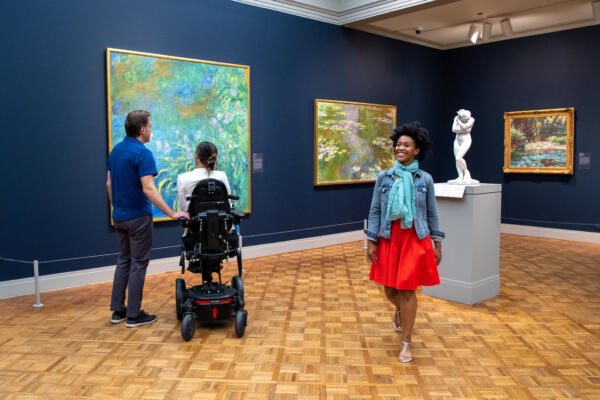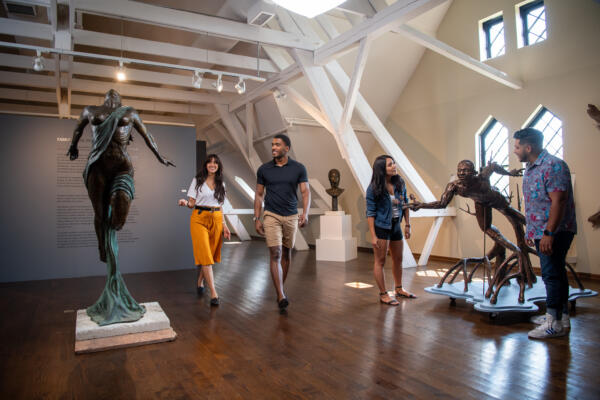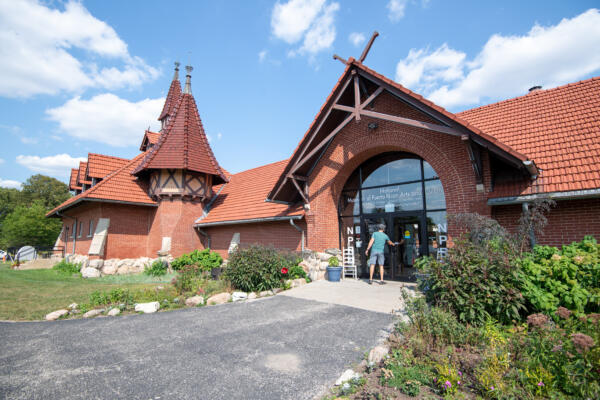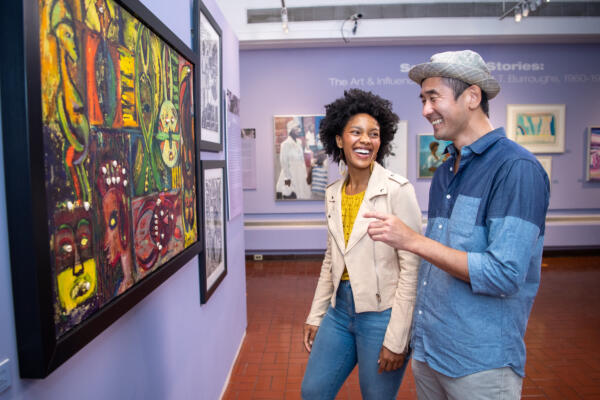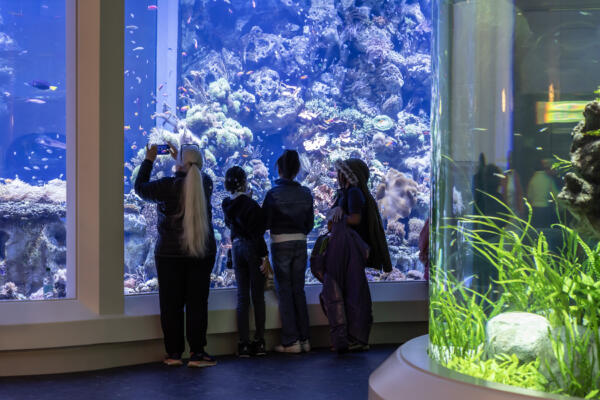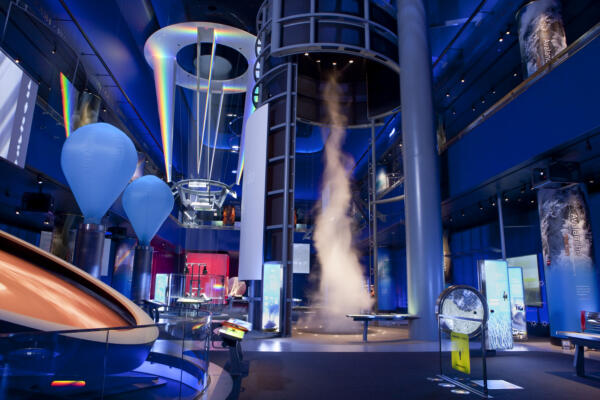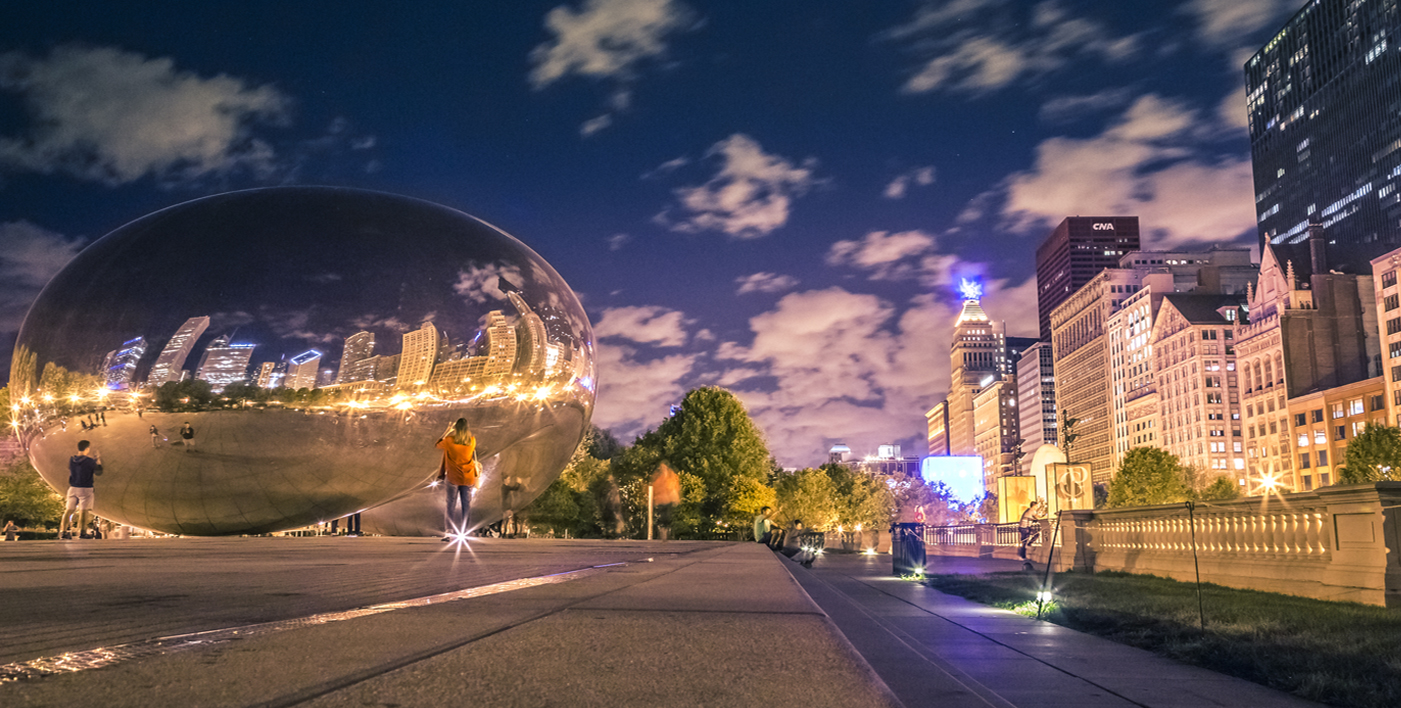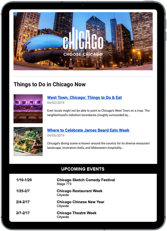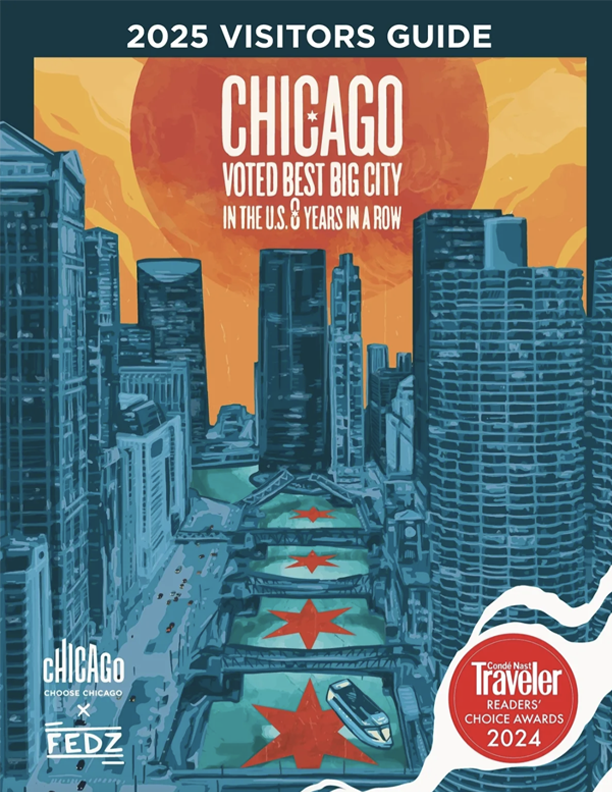Chicago is something of a public art mecca. You’ll find famous pieces by renowned international names and under-the-radar works by local artists around practically every corner of the city, including more than 500 works in our parks, streets, university campuses, libraries, airports, and beyond.
Public art in Chicago
Strolling Chicago’s streets, you’ll stumble across works by Picasso, Chagall, Miro, Calder, and more legendary artists, nestled alongside colorful murals and thought-provoking works by Chicagoans — transforming the city into an urban art museum.
Here are just a few of the must-see masterpieces to get you started, from our buzzing downtown to our vibrant neighborhoods.
Public art in Chicago’s Loop
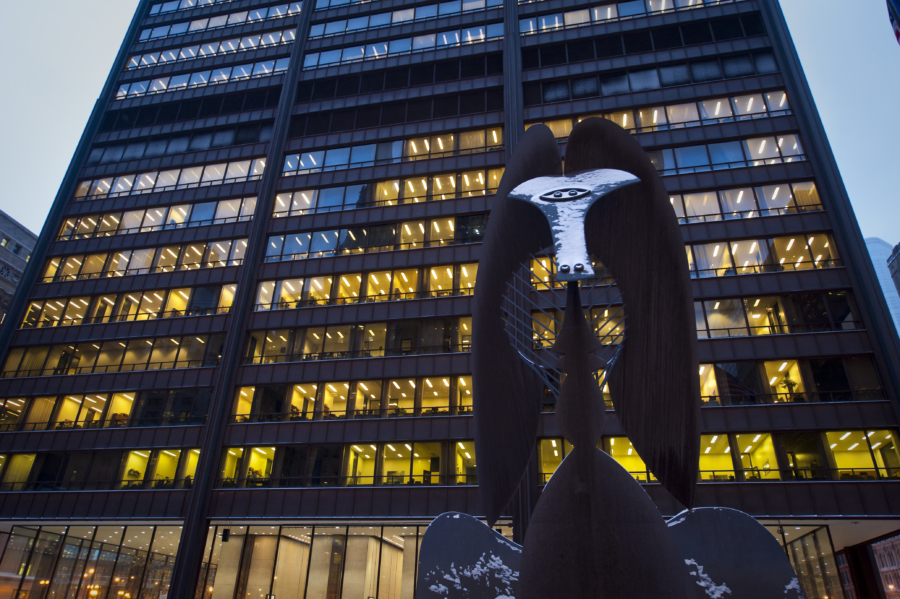
The Picasso by Pablo Picasso
Standing 50 feet tall and weighing over 160 tons, The Picasso, as it is known, is an untitled sculpture that some liken to an insect or baboon. Pablo Picasso gifted the sculpture to the people of Chicago in 1967, without ever explaining what it was intended to represent. Today, it’s one of the city’s most famous and iconic public artworks. Taking two years to create, Picasso combined and modified sketches and motifs from his earlier works to develop his concept. The resulting 42-inch-tall model of the sculpture can be seen at the Art Institute of Chicago, along with the artist’s sketches for the piece. 50 W. Washington St.
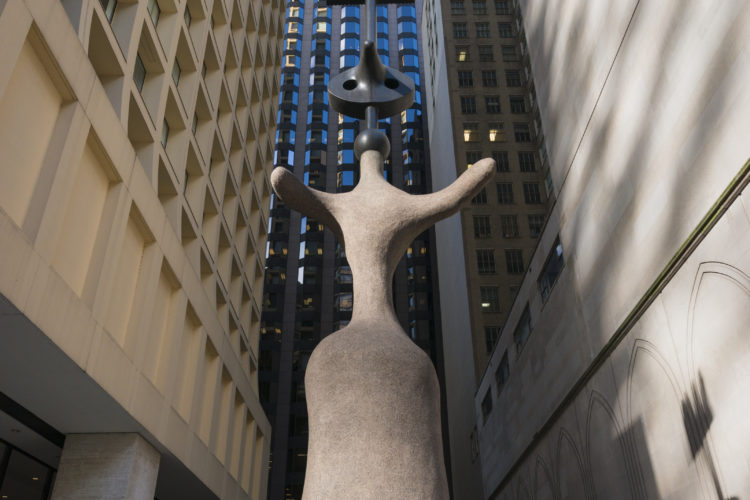
Chicago by Joan Miró
Joan Miró’s mixed-media sculpture stands approximately 40 feet tall and is composed of steel, wire mesh, concrete, bronze, and ceramic tile. It’s a celestially inspired work, representing a female figure with a moon at her center and a star above her head. At the same time, her bell-shaped base stresses her closeness to the earth. As with many groundbreaking works, the immediate public response upon the sculpture’s 1981 unveiling wasn’t all positive. One member of the public even threw a can of paint over it. But today, “Miss Chicago,” as the sculpture is affectionately known, is beloved by all. Brunswick Building Plaza, 69 W. Washington St.
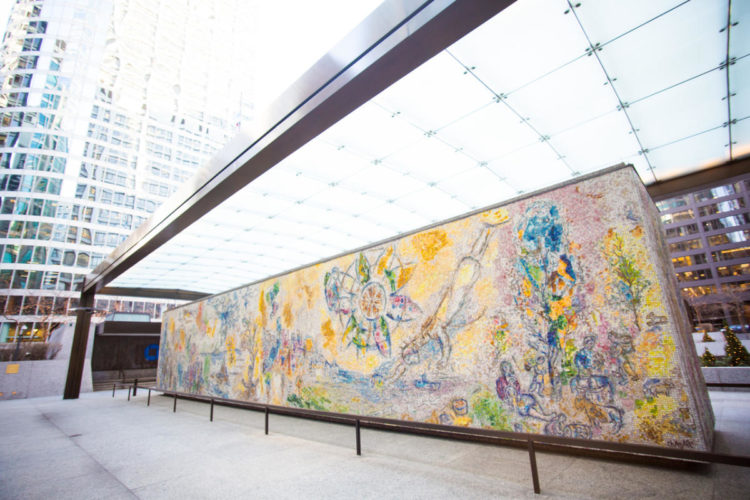
The Four Seasons by Marc Chagall
Composed of thousands of inlaid chips in over 250 colors, the design for this mosaic was created in Chagall’s studio in France, transferred onto full-scale panels, and installed in Chicago with the help of a skilled mosaicist. Even after its arrival, Chagall continued to modify his design, updating those areas that featured the city skyline (last seen by the artist 30 years before the mosaic’s installation). He also added pieces of native Chicago brick. In its entirety, the mosaic portrays the four seasons through six Chicago scenes, filled with birds, fish, flowers, suns, and pairs of lovers. Chagall commented that, “the seasons represent human life, both physical and spiritual, at its different ages.” Chase Tower Plaza, 10 S. Dearborn St.
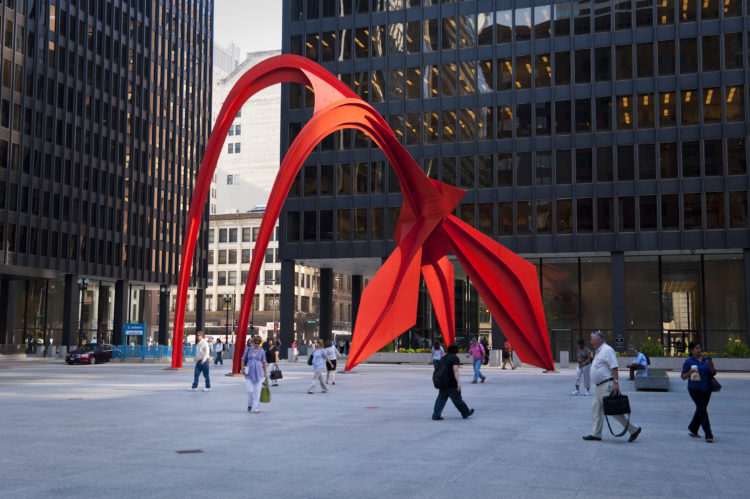
Flamingo by Alexander Calder
You can’t miss Alexander Calder’s 53-foot-tall, bright red Flamingo, with its curved lines contrasting dramatically with the steel and glass Mies van der Rohe buildings that surround it. Though weighing 50 tons, Flamingo features an open design that invites you to walk under and around it. Flamingo was unveiled in 1974 and remains one of Chicago’s most distinct icons. Federal Plaza, 50 W. Adams St.
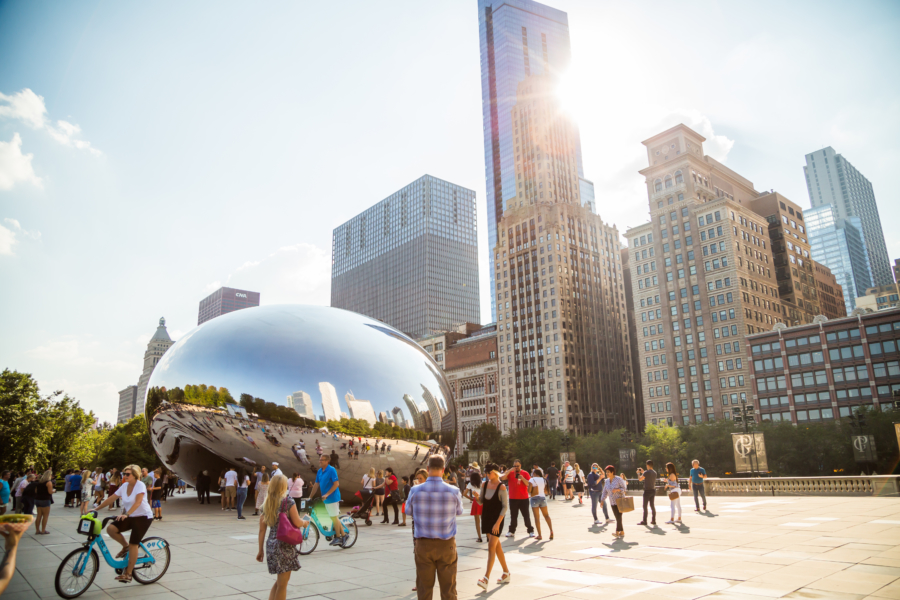
Cloud Gate, aka “The Bean” by Anish Kapoor
Its official name is Cloud Gate, but this much-loved sculpture is definitely “The Bean” to locals. Measuring 66-feet long by 33-feet high, and weighing a colossal 110 tons, it’s among the largest sculptures of its kind in the world, and was British artist Anish Kapoor’s first U.S. public outdoor artwork. The elliptical sculpture, which was inspired by mercury, utilizes a seamless series of highly polished stainless steel plates that reflect Chicago’s famous skyline on its surface. A 12-foot-high arch provides a “gate” to Millennium Park, inviting visitors to enter, touch its mirror-like steel, and see their distorted images reflected back at them. 201 E. Randolph St., between Michigan Ave. & Columbus Ave.
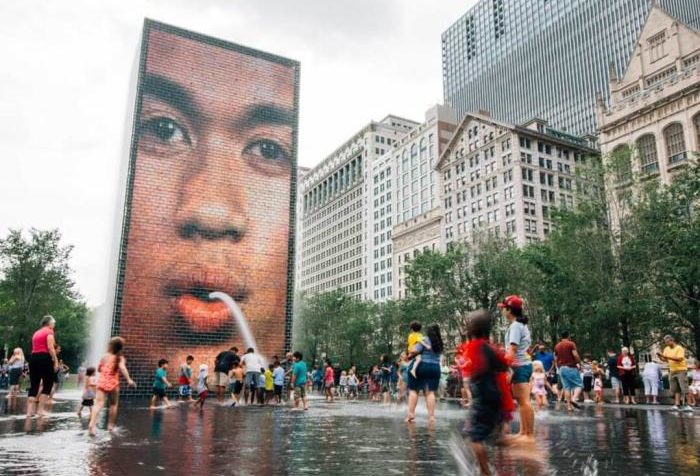
Crown Fountain by Jaume Plensa
Designed by Spanish artist Jaume Plensa, Crown Fountain is a highly interactive art installation consisting of two 50-foot glass block towers at each end of a shallow reflecting pool. The towers project video images of Chicago locals, who spout jets of water from their pouting lips. The design was inspired by the tradition of using gargoyles in fountains, sculpted with open mouths to allow water, a symbol of life, to flow. See the fountain in action from mid-spring to mid-fall, with LED images remaining on view year-round. Millennium Park, 201 E. Randolph St., between Michigan Avenue and Columbus Avenue.
Monument with Standing Beast by Jean Dubuffet
Beginning with an exhibition at the Arts Club of Chicago in 1951, French artist Jean Dubuffet forged a special connection with Chicago, home to one of only three monumental Dubuffet commissions in the United States. The artist’s 29-foot-tall, 10-ton fiberglass Monument with Standing Beast is composed of four elements that suggest a standing animal, a tree, a portal, and an architectural form. You can’t help but want to enter the sculpture and explore — just as the artist had intended (he wanted to create a work that would resonate with the average person on the street). Affectionately referred to as “Snoopy in a blender” by locals, the artist described the sculpture as a “drawing which extends…into space.” It’s a great example of Dubuffet’s Art Brut style, which mimicked visual works produced by children and untrained artists. Temporarily out of public view
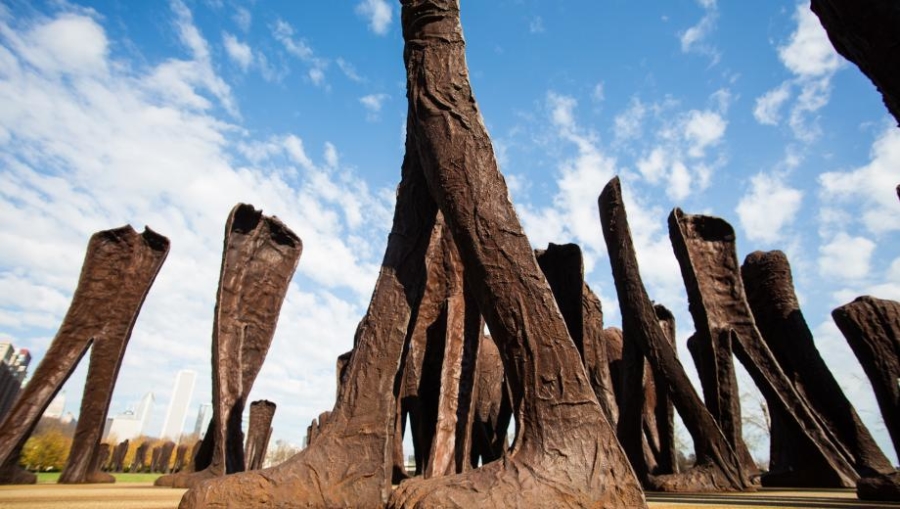
Agora by Magdalena Abakanowicz
Located along the southwest side of Grant Park, Agora derives its name from the Greek word for meeting place. This striking cast-iron art installation comprises 106, 9-foot-tall headless torsos. The figures are posed either walking in groups in various directions or standing still. Internationally renowned Polish artist Magdalena Abakanowicz donated the sculptural group in cooperation with the Polish Ministry of Culture and other private donors. Although Abakanowicz has frequently exhibited in museums and public spaces throughout the world, Agora remains her largest permanent installation. Grant Park, South Michigan Avenue & East Roosevelt Drive
Bronze Cow by Nathan Mason
In 1999, a herd of fiberglass cows united citizens, visitors, and businesses through a unique community-based public art event, Cows on Parade, that called upon local artists to produce designs to decorate each unadorned bovine. The commemorative bronze cow you’ll meet outside the Chicago Cultural Center was created by Nathan Mason in 2001, as a gift from the Hanig family (responsible for bringing the Cows on Parade event to Chicago all the way from Zurich, Switzerland). Look closely, and you’ll see two famous Chicago landmarks — The Picasso and Historic Water Tower — reflected in the cow’s eyes. 78 E. Washington St.
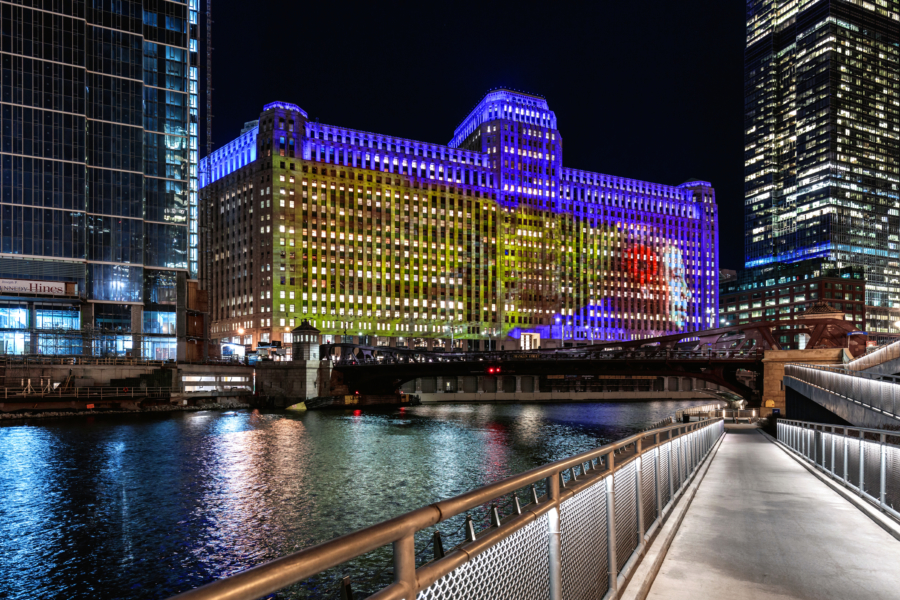
ART on THE MART by various artists
Chicago’s significant public art and cultural legacy continues to this day. And nowhere is this better seen than at ART on the MART, the largest video-projection art installation in the world. Approximately 2.5 acres of the MART’s Chicago Riverwalk-facing facade has become a next-generation public art space, with curated international and local video art projected seasonally. 222 W. Merchandise Mart Plaza
Muddy Waters mural by Eduardo Kobra
In 2016, the late, great Chicago blues musician Muddy Waters was honored with a nine-story mural by internationally acclaimed Brazilian street artist Eduardo Kobra. A kaleidoscope of bright colors and bold lines are the artist’s trademark — you can’t miss them as you walk along State Street towards Washington Street. Kobra is known the world over for his massive murals of famous people, including musicians Bob Dylan in Minneapolis and David Bowie in Jersey City. His Muddy Waters Mural is part of the Wabash Arts Corridor, a Chicago hotspot for street art devotees. 17 N. State St.
Rushmore by Kerry James Marshall
Artist and MacArthur Fellow Kerry James Marshall designed an epic mural for the Chicago Cultural Center’s Garland Court facade, honoring 20 women who shaped the city’s arts and culture scene. At 132-feet by 100-feet, this is the largest artwork Marshall has ever conceived. It’s an explosion of bright pinks, greens, golds, and purples, depicting the likes of dancer and choreographer Ruth Page, cultural icon Oprah Winfrey, and Barbara Gaines, founder and artistic director of the Chicago Shakespeare Theater. Marshall’s vision for the mural was executed by artist Jeff Zimmermann and his team from Jazim, Inc. Garland Court, 78 E. Washington St.
From Doom to Bloom by Collin van der Sluijs
This powerful jewel-toned mural by Dutch artist Collin van der Sluijis depicts two indigenous Illinois birds against larger-than-life blooms. At its heart, the work conveys triumph over adversity, and, ultimately, hope. The yellow-headed blackbird depicted was once common in Chicago, but has since disappeared, while the red-headed woodpecker is in danger of meeting the same fate. Van der Sluijs’ work, which tends to focus on “personal pleasures and struggles in daily life,” has been exhibited throughout Europe and in the United States. 1006 S. Michigan Ave.
Explore more: The Wabash Arts Corridor is home to around 20 large-scale murals in a seven-block stretch.
Make Your Own Luck by ASVP
ASVP is a Brooklyn-based printmaking and street art studio founded by artists Simon Grendene and Victor Anselmi. The duo’s mural, Make Your Own Luck, was created as part of Vertical Gallery’s The Power of Paint series, which focused on the idea of using art to help others. It’s a must-see work, emblazoned in red, white, and blue, with clear nods to advertising, pop, and comic-book culture — an ASVP trademark. 1 E. Balbo Drive, South Loop Club
Moose Bubblegum Bubble by Jacob Watts
You can’t help but love Moose Bubblegum Bubble, a photo mural created by former Columbia College student Jacob Watts, one of the winners in the 2014 Columbia College Chicago’s Wabash Arts Corridor Campus competition. It’s whimsy at its best, with an enigmatic moose blowing a gigantic bubblegum bubble (which you likely gathered from the mural’s title). If you happen to be on a CTA Green Line or Orange Line ‘L’ train as it rounds the curve south of East Ida B. Wells Drive, you’ll get a perfect elevated view of the work. 33 E. Ida B. Wells Drive
Looking for more? Check out this guide to public art from the Chicago Loop Alliance.
Public art in Chicago’s neighborhoods
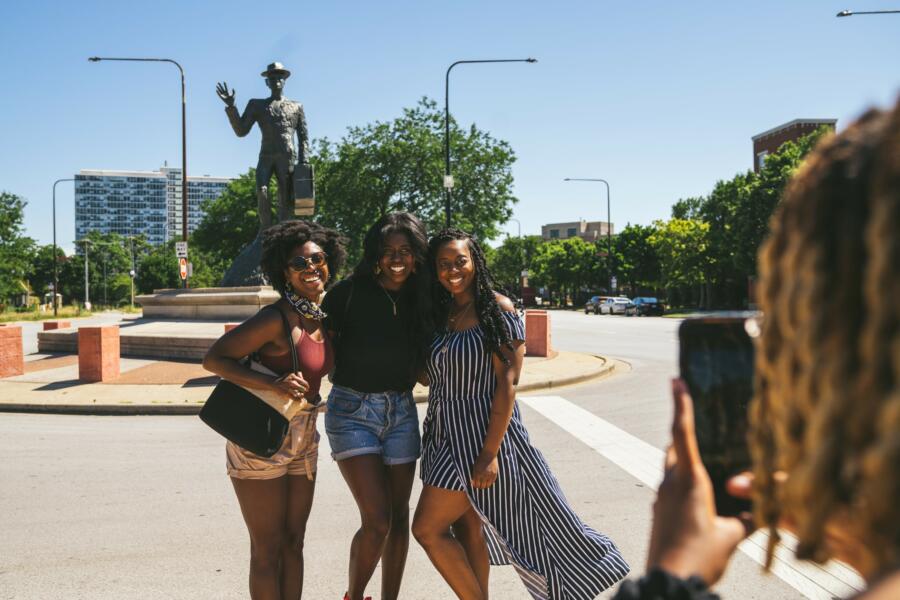
Monument to the Great Northern Migration
Alison Saar’s bronze figure is a testament to the thousands of African Americans who migrated to Chicago in the early 20th century in search of greater freedom and opportunity. The traveler depicted bids hello to his new home, while carrying a worn suitcase that represents his journey and dreams. The bollards surrounding the work are also suitcases, textured with a pattern inspired by the era’s tin ceilings. The figure faces north, symbolizing his progress toward his destination. Dr. Martin Luther King Jr. Dr. & 26th Place, Bronzeville
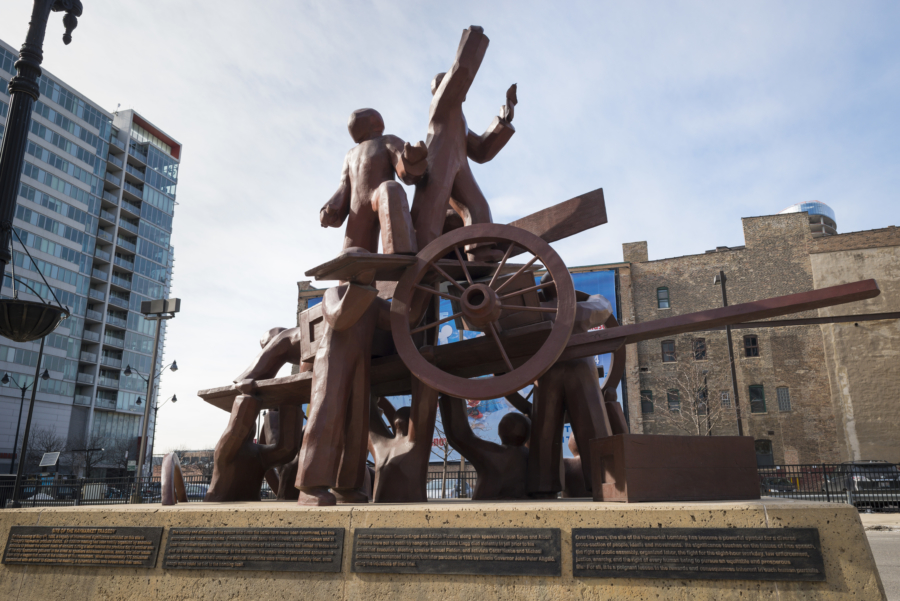
The Haymarket Memorial
On May 4, 1886, a meeting organized by anarchist activists to protest the deaths of workers during a labor lockout resulted in a tragic bombing that claimed the lives of seven policemen and at least four civilians. Over the years, the site of the Haymarket bombing has become a powerful symbol of the right to free speech, public assembly, organized labor, and justice. The wagon that anchors Mary Brogger’s sculpture in The Haymarket Memorial alludes to the speakers’ platform used during the meeting, and marks the precise spot where the bombing occurred. 175 N. Desplaines St., West Loop
Rara Avis
Located at Chicago Midway International Airport, Ralph Helmick and Stuart Schecter’s installation is a monumental suspended sculpture that symbolically links natural and manmade aviation. It consists of thousands of pewter elements, employing 3D pointillism to achieve the impression of a graceful cardinal, Illinois’ state bird. Move closer, and you’ll notice more than 2,500 small renderings related to air travel. Over 50 different aircraft are represented, including Leonardo da Vinci-inspired designs, 19th-century balloons, and classic passenger airliners. S. Cicero Ave. & W. 63rd St., Midway
Nuclear Energy
Henry Moore’s 12-foot bronze sculpture commemorates the birthplace of the world’s first man-made, self-sustaining nuclear chain reaction in motion in 1942. This achievement occurred at Chicago Pile 1, the world’s first artificial nuclear reactor, built under the original site of the University of Chicago‘s Stagg Field. The sculpture was installed in 1967, exactly 25 years later. Moore remarked that, “Like anything that is powerful, it has a power for good and evil…the lower part [of the sculpture] is more architectural and in my mind has the kind of interior of a cathedral with sort of a hopefulness for mankind.” Ellis Avenue between 56th and 57th Streets, Hyde Park
Snow Sculpture for Chicago
Chicago artist Tony Tasset created this whimsical, conceptual piece as a hyper-realistic depiction of a pile of snow, displayed in the west window of the Goldblatt’s building façade (the former department store’s only remaining display window). Tasset even included pieces of handcrafted debris, including coffee cups and matchbooks. He explains that, “these piles of snow are sublime; both ugly and beautiful, like life.” 1613 W. Chicago Ave., West Town
Fountain of Time
Famed artist Lorado Taft created a sculptural allegory of humanity’s relationship with time, set within picturesque Washington Park. A reflecting pool and a 110-foot-long mass of figures represent the themes of love, war, and the cycle of life. All seem to strain in unison across the pool toward a tall, solitary figure, making this one of Chicago’s most hauntingly beautiful public artworks. Cottage Grove Ave. & 59th St., Hyde Park
I Will
“I Will” was the motto adopted by Chicagoans after the Great Chicago Fire of 1871. The hollow, minimalist column, crafted from stainless steel, rises from the ground as a symbol of Chicagoans’ determination in overcoming the fire’s destruction. The simple column shape also alludes to Chicago as the birthplace of the modern skyscraper, part and parcel of the city’s rebirth, and an enduring symbol of the city’s architectural influence. Fullerton Ave. & Cannon Dr., Lincoln Park

